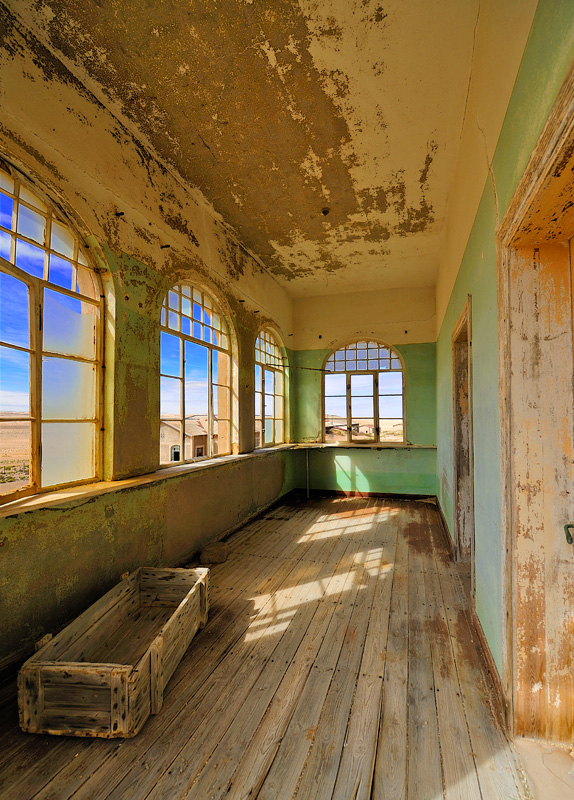NB01-29
Kolmanskop, Namibia
Kolmanskop (Afrikaans for Coleman's hill, German: Kolmannskuppe) is a ghost town in the Namib desert in southern Namibia, a few kilometres inland from the port town of Lüderitz. It was a small mining village and is now a popular tourist destination run by the joint firm NamDeb (Namibia-De Beers).
It developed after the discovery of diamonds in the area in 1908, to provide shelter for workers from the harsh environment of the Namib Desert. The name originates from a transport driver named Johnny Coleman who during a sand storm abandoned his ox wagon on a small incline opposite the settlement.
Driven by the enormous wealth of the first diamond miners the village was built like a German town, with facilities like a hospital, ballroom, power station, school, skittle-alley, theater and sport-hall, casino, ice factory and the first x-ray-station in the southern hemisphere as well as the first tram in Africa. It had a railway link to Lüderitz.
The town declined after World War I as diamond prices crashed, and operations moved to Oranjemund. It was abandoned in 1956 but has since been partly restored. The geological forces of the desert mean that tourists can now walk through houses knee-deep in sand. Kolmanskop is popular with photographers for its scenic settings of the desert sands reclaiming this once thriving town. Due to its location within the restricted area (Sperrgebiet) of the Namib desert, a permit is necessary to enter the town.











Stephen Leary 21/10/2010 18:52
Great picture. What technique did you use for this? Is it a tone mapped HDR?Kambiz Bagheri 28/08/2010 7:26
I feel i'm there!DRAGA PUC 03/04/2010 13:30
grerat series, Sergio.have a nice holidays.
draga
Regina Bliem 25/10/2009 19:12
super pic !I would like to use it for working with childrens -only this pic should give an imput for a text.
Would you allow me to use this ?
regards
regina - teacher for kids from 10 to 14 .
austria
decay 22/10/2009 12:41
Hammer was für ne starkePersepktive, ich finde es
wirklich total klasse!
Sehr gut gemacht!
lg
Adriana Massl 22/10/2009 11:50
I love this,It could be my home, anywhere...
Matthias Besant 22/10/2009 10:47
+++Alexandra Baltog 19/10/2009 16:24
fine angle...and exposure, sure!Michael Grotkamp 19/10/2009 11:15
Koolmanns`s Kopje... Superbe light, top detailsand great look in, wonderful documentation.Michael
Mattia Sacco 18/10/2009 22:07
Luce e colori d' Africa.